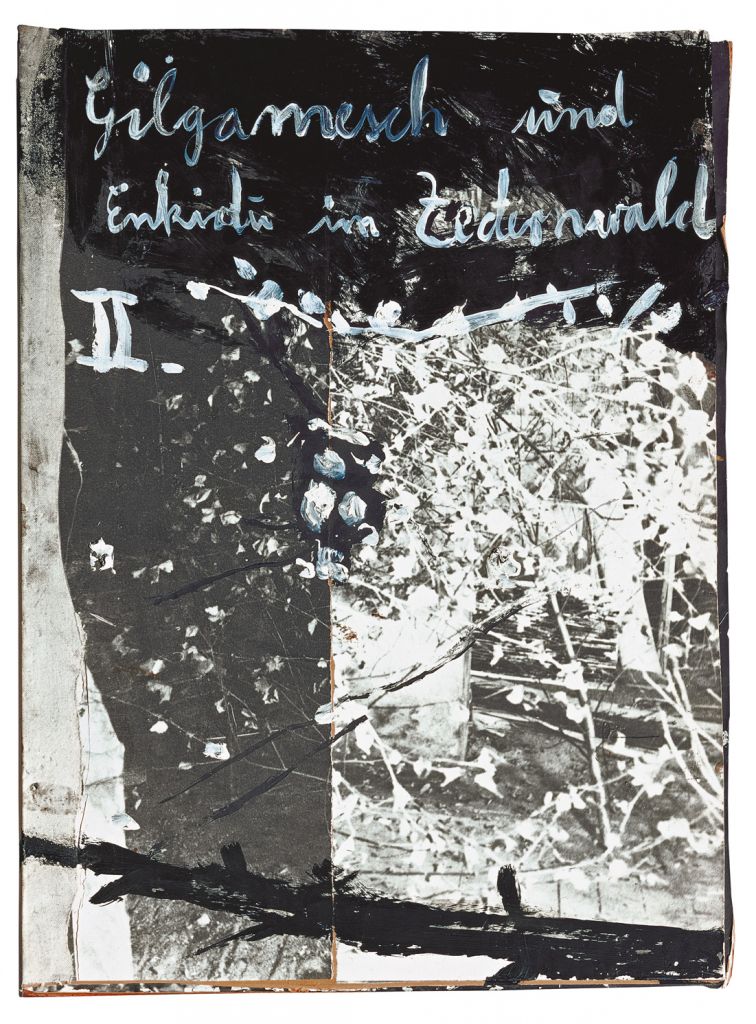Only with Wind, Time, and Sound
1997Acrylic and emulsion on canvas473 x 944 x 22 cm
Born in Germany just months before the final European battle of World War II, Anselm Kiefer grew up witnessing the results of modern warfare and the division of his homeland. He also experienced the rebuilding of a fragmented nation and its struggle for renewal. Kiefer dedicated himself to investigating the interwoven patterns of German mythology and history and the way they contributed to the rise of Fascism. He confronted these issues by violating aesthetic taboos and resurrecting sublimated icons. In one of his earliest projects, his 1969 Occupations (Besetzungen)series, Kiefer photographed himself mimicking the Nazi salute at various sites during a journey through Switzerland, France, and Italy. Subsequent paintings—immense landscapes and architectural interiors, often encrusted with sand and straw—invoke Germany's literary and political heritage; references abound to the Nibelung legends and Richard Wagner, Albert Speer's architecture, and Adolf Hitler. Beginning in the mid-1980s, and especially following his move to southern France in the early 1990s, Kiefer's iconography expanded to encompass more universal themes of civilization, culture, and spirituality, drawing upon such sources as the Kabbalah, alchemy, and ancient myth.
Only with Wind, Time, and Sound (Nur mit Wind, mit Zeit und mit Klang, 1997) is part of a series of large-format works featuring pyramids and other large ancient structures. Kiefer began the series (which also comprises books) in 1996, drawing his inspiration from photographs taken during his travels through the Americas and Asia. Tall buildings and towers are particularly meaningful in the German artist's work; as in the ancient Egyptian world, where pyramids were considered to be places of transit between this world and the next, Kiefer describes these monuments as being between "heaven and earth."[1] The title of this piece-which appears in an inscription above the pyramid-was taken from the poem "Exile" by the 20th-century Austrian poet Ingeborg Bachmann. Like Bachmann, who experienced World War II as a child, Kiefer bases a large part of his work on distant, ancient wars to brood on the destructive cycle of history.
1. Cfr. Arasse, D. Anselm Kiefer. London, Thames and Hudson, 2001. pp. 268–74.
Source(s):
Nancy Spector. "Anselm Kiefer." In Spector, ed. Guggenheim Museum Collection: A to Z. 3rd rev. ed. New York: Guggenheim Museum, 2009.
Miguel López-Remiro. "Anselm Kiefer." In Guggenheim Museum Bilbao Collection. Bilbao: Guggenheim Museum Bilbao; Madrid: TF Editores, 2009.
"Anselm Kiefer." In The Permanent Collections of the Guggenheim Museums. Bilbao: Guggenheim Museum Bilbao, 2007.
Original title
Nur mit Wind, mit Zeit und mit Klang
Date
1997
Medium/Materials
Acrylic and emulsion on canvas
Dimensions
473 x 944 x 22 cm
Credit line
Guggenheim Bilbao Museoa
Perspectives
Only with Wind, Time, and Sound, by Anselm Kiefer
Paco León, actor and director, and Marta Blàvia, member of the Museum’s curatorial staff, unveil the secrets of Anselm Kiefer’s impressive large-format work Only with Wind, Time, and Sound (Nur mit Wind, mit Zeit und mit Klang, 1997): the symbolic meaning of the pyramid, the trauma of war and the need to overcome it, and the need to understand history.










